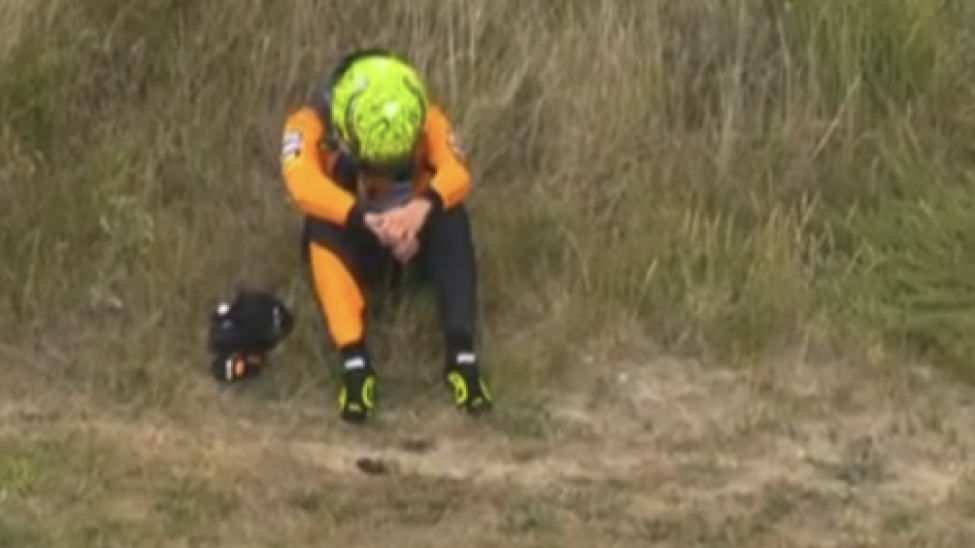The smell of burning oil and the sight of smoke were the first signals that something was terribly wrong. For Lando Norris, who had driven a near-perfect race, the Dutch Grand Prix was collapsing around him in the most gut-wrenching way possible. With just seven laps remaining, the checkered flag almost in sight, his McLaren sputtered to a halt, a plume of smoke trailing behind it like a ghost. The dream of a podium finish, of closing the gap in the championship, vanished into the sea breeze at Zandvoort. Norris was out. A Did Not Finish (DNF) was now etched next to his name, a brutal conclusion to what had been a masterclass in driving.

From the cockpit, the frustration was palpable. Norris had been running comfortably in second place for most of the race, holding his own against the relentless pressure from behind. He had managed his tires brilliantly, executed a flawless strategy, and showcased the raw talent that has made him one of Formula 1’s brightest stars. But in motorsport, a driver is only as good as the machine beneath them, and on this day, his machine had failed him. The DNF was not just a loss of points; it was a significant psychological blow, widening the chasm between him and his teammate, Oscar Piastri, to a daunting 34 points in the title fight.
In the high-stakes world of Formula 1, where millions are invested in the pursuit of perfection, a mechanical failure is the ultimate betrayal. For McLaren, the incident was a stark reminder of the sport’s inherent cruelty. Team Principal Andrea Stella, a man known for his calm and analytical demeanor, fronted the media with a somber expression. He confirmed that the initial investigation pointed not to an issue with their Mercedes engine supplier, but to a problem with the chassis itself—a component built and designed in-house. “We identified a chassis-side issue,” Stella explained, his words carefully chosen. “We will need to conduct a full review to understand the root cause before we head to Monza.”
The diagnosis, while sparing Mercedes any blame, placed the responsibility squarely on McLaren’s shoulders. Further investigation from sources within the paddock, later reported by The Race, suggested a minor part failure had led to a critical oil leak. This leak triggered a cascade of events: onboard sensors screamed warnings to the electronic control unit, which, in a pre-programmed act of self-preservation, shut down the engine to prevent catastrophic damage. It was a small failure with massive consequences, a tiny crack in the armor that brought a charging chariot to a grinding halt.

While Norris was left to contemplate what could have been, his teammate Oscar Piastri inherited the second-place trophy. But there was no overt celebration from the young Australian. Piastri, with a maturity that belies his years, understood the precarious nature of success in this sport. “A 34-point lead doesn’t feel comfortable at all,” he admitted post-race. “It shows how quickly things can change. One DNF for me and a win for Lando, and that gap is almost gone. We have to keep pushing, keep winning races. You can’t afford to relax for a second.” His words were a testament to the respect between the two drivers and a clear acknowledgment that the championship fight was far from over.
Now, all eyes turn to the Temple of Speed: Monza. The iconic Italian circuit, with its long straights and high-speed corners, is a place where engine power is paramount. But for Norris, the upcoming race weekend is fraught with peril. The DNF at Zandvoort has created a new and pressing concern—the risk of a grid penalty. Before the Dutch Grand Prix, Norris was already on the limit with most of his allocated power unit components for the season. Exceeding this limit automatically triggers a penalty, forcing him to start further down the grid and turning his race into an uphill battle before it even begins.

The crucial question for the McLaren engineers is whether the engine shutdown at Zandvoort caused any terminal damage to the existing components. The silver lining, if one can be found, is that the shutdown was triggered by an external issue (the oil leak) rather than an internal engine failure. This increases the likelihood that the engine itself, and its associated parts, may have survived unscathed. If the team can salvage the current power unit, Norris might just escape the dreaded penalty. However, if any component was compromised, they will have no choice but to introduce a new set, forcing Norris to fight his way through the pack at one of the most difficult tracks for overtaking.
This single incident encapsulates the razor-thin margins that define a Formula 1 championship. It’s a battle fought not just on the track between drivers, but in the factories and garages by thousands of engineers and mechanics. It’s a relentless pursuit of performance and reliability, where the smallest oversight can unravel a season’s worth of hard work. For Lando Norris, the Dutch Grand Prix was a bitter pill to swallow. It was a reminder that in his quest for a maiden world title, he is not just racing against his rivals; he is racing against the very limits of engineering and, sometimes, against sheer bad luck. As the F1 circus packs up for Monza, the pressure has been dialed up to eleven. Norris must now channel his frustration into a comeback drive, knowing that every point is precious and that the ghost of Zandvoort will be looming large in his rearview mirror. The championship is not lost, but the path to glory just became significantly steeper.
News
Die Sprache der Liebe: Wie Bushido und Anna-Maria Ferchichi ihre 15-jährige Ehe in der Paartherapie retteten – Das emotionale Geständnis der „Liebessprachen“-Krise
Die Ehe von Bushido und Anna-Maria Ferchichi gehört seit Jahren zu den am meisten beachteten Partnerschaften der deutschen Öffentlichkeit. Sie…
Tanzwunder im siebten Monat: Renata Lusin tanzt hochschwanger! Das emotionale Comeback und die bewegende Geschichte des “Campingbabys”.
Die Nachricht schlug in der deutschen Medienlandschaft ein wie ein funkelnder Diskokugel-Blitz: Renata Lusin, die charismatische und stets energiegeladene Profitänzerin,…
Antonia Hemmer enthüllt das bestgehütete Geheimnis: „Er ist derjenige, für den ich gebetet habe“ – Ein Beweis von Liebe, Schutz und Selbstbestimmung
Es war ein einziger digitaler Atemzug, der die gesamte Reality-TV-Welt in ihren Bann zog und die Gerüchteküche zum Überkochen brachte….
Schock-Nachricht beim TV-Comeback: Helene Fischer kündigt Mega-Pause für ihre große Stadion-Tour an!
Die Schlagzeilen über Helene Fischer sind meist ein Spiegelbild von Superlativen: Rekorde, ausverkaufte Stadien, atemberaubende Spektakel. Doch nach der Geburt…
Anna Heiser: „Was sich wie ein Ende anfühlte, war unsere Rettung“ – Die dramatische Wahrheit hinter Ehekrise, Existenzangst und dem radikalen Neuanfang
Wenn Anna Heiser (35) heute mit ihrem Mann Gerald und ihren Kindern Leon (4) und Alina (3) glücklich um den…
Zwischen Blitz-Einsatz und Glamour-Verwandlung: Katja Burkards ungeschminkter Sprint zur Rettung der RTL-Show Denn sie wissen nicht, was passiert
Der Samstagabend ist in der deutschen Fernsehlandschaft traditionell die Hochburg der großen Unterhaltung, der Ort, an dem sich TV-Ikonen in…
End of content
No more pages to load











